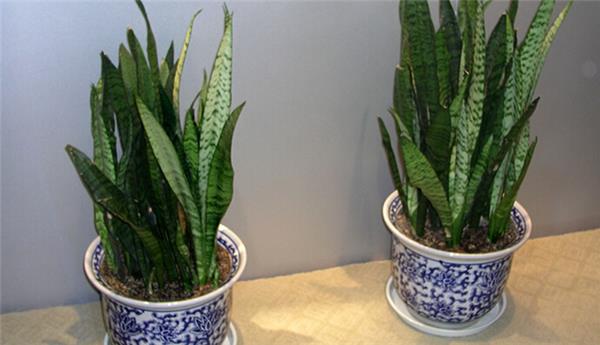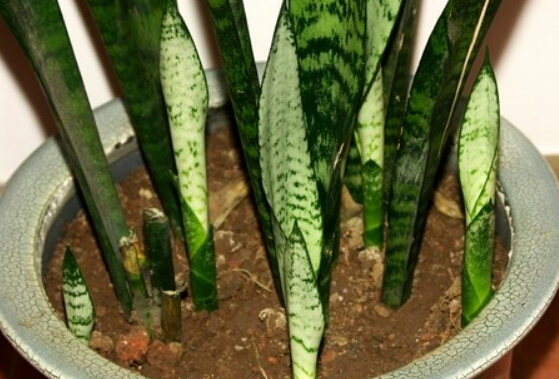The breeding method and classification of tiger skin orchid that have to be learned
Tiger Pilan is a perennial herbaceous foliage plant with heavy roots, linear lanceolate, strong adaptability and lax requirements on the living environment. It is very suitable for decorating living room and study lamp places. In addition to providing viewing, the biggest feature is that it can purify the air. According to experts, Tiger Pilan can absorb more than 80% of indoor harmful gases, especially for formaldehyde, especially in newly decorated houses. And tiger skin orchid can also protect against radiation, in view of these characteristics, we can roughly draw the tiger skin orchid culture method:

First, the choice of soil
Tiger skin orchid soil needs to be loose and needs to be breathable, so when allocating soil for tiger skin orchid, we must pay attention to the rotten leaves of 2 and 3 and the garden soil of 1. Keep in mind that the soil must be loose and breathable, otherwise the water will not evaporate easily and lead to rotting of the rhizome.
Second, the demand for sunshine
Tiger Pilan likes the light, so be sure to let it often come into contact with the sun, it is best to put it in a place where it can be irradiated directly, and if the conditions do not permit, it should also be placed in a place close to the sun and placed in a dark place for a long time. It will cause the leaves to turn yellow.
Third, temperature
Tiger skin orchid requires a high temperature, its suitable growth temperature is 20-30 ℃, the lowest in winter is not less than 10 ℃, so we must pay attention, especially in the north.
Fourth, watering
Tiger Pilan also has a high demand for water. generally speaking, if the soil is loose, it needs to be watered twice a week, while in winter, it only needs once because of the climate.
Fifth, pruning
The growth rate of tiger skin orchid is faster than that of other domestic green plants, so when the basin is full, it is necessary to carry out artificial pruning, mainly to cut off the old leaves and places that are too lush to ensure its sunshine and growth space.

Sixth, change the basin
Tiger Pilan is a perennial plant, generally speaking, it is necessary to change the basin every two years, and pay attention to adding nutrients to the new soil when changing the basin, so as to ensure its nutritional supply.
Seventh, planting methods
Tiger Pilan is a root plant, generally speaking, only a few plants need to be planted, and after a year, the whole basin will be harvested. When planting, you should first put part of the soil under the basin, then plant it from one side of the basin and plant it evenly in the basin.
Eighth, fertilization
Tiger Pilan does not have high requirements for fertilizer, it only needs to be fertilized twice a month in the growing season, pay attention to the application of thin liquid fertilizer, so as to ensure luxuriant growth.
Ninth, the threat of disease and insect pests
The common diseases of tiger skin orchid are leaf spot and anthracnose, which can be treated by spraying more than 50% carbendazim; common insect pests are harmful to weevil, which can be sprayed with 1000 times of fenitrothion EC.
I believe many people have heard of the role of Tiger Pilan in the home environment. Together with Cymbidium, Tortoise back Bamboo and Golden Bamboo, it is four kinds of plants with super air purification ability. So, what kind of role does Tiger Pilan play in home life?

1. Hu Pilan can increase the concentration of indoor negative ions. It can absorb carbon dioxide and release oxygen at the same time, increasing the concentration of negative ions in indoor air. Negative ion is a kind of negatively charged gas ion in the air, which has a very important influence on the life activities of human body and other organisms. The stomata on the fleshy stem of Tiger Pilan are closed during the day and open at night, which can release a large number of negative ions while absorbing carbon dioxide, increasing the concentration of negative ions in the indoor air. Moreover, Tiger Pilan also has an important role in radiation protection, which is suitable for display next to computers and televisions. Therefore, in home apartments, office buildings and other places, Phnom Penh tiger tail orchid has gradually become the preferred environmental protection plant.
2. It can absorb many harmful gases. Like the hanging orchid, Hu Pilan can absorb more than 80% of the indoor harmful gases, the ability to absorb formaldehyde is even stronger, and is known as the "natural scavenger." At the same time, it can also absorb a large number of radionuclides such as uranium. in addition to removing formaldehyde, it has obvious absorption of harmful materials such as trichloroethylene, hydrogen sulfide, benzene, phenol, hydrogen fluoride, ether, heavy metal particles and so on. transpiration efficiency is high, but also has a certain ability to adjust indoor humidity. Therefore, in the bedroom of 15 square meters, planting 2-3 pots of tiger skin orchid can keep the air fresh. Tiger Pilan has also become an indispensable environmental protection indoor plant in people's modern life.

Tiger Pilan is mainly distributed in Africa and southern Asia, belonging to angiosperm phylum, lilium. Tiger skin orchid, also known as tiger tail orchid, millennium orchid, is a kind of perennial evergreen plant. Tiger Pilan's leaves are very tall and straight, like little green guards, usually with stripes in the shape of a tiger's tail. The Phnom Penh tiger skin orchid is a kind of tiger skin orchid with high appreciation, its leaves are generally composed of green, white and yellow, and the leaf edge is pure yellow, which is also the origin of the name Phnom Penh tiger skin orchid. So, what are the kinds of tiger skin orchid?
The common cultivated varieties of tiger tail orchid are:
Phnom Penh tiger tail orchid: shaped like tiger tail orchid, but the leaf edge is inlaid with a golden broad-spotted band.
Onion leaf tiger tail orchid: also known as pillar leaf tiger tail orchid. The leaf is cylindrical, the whole leaf is about the same thickness up and down, the end is slightly pointed and thin, the leaf surface has a longitudinal shallow groove, and each leaf grows independently.
Magnolia przewalskii: it is a dwarf species with a plant height of about 10 mi 20 m. It is a mutant of Phnom Penh with short and wide leaves and overlapping growth.

The above is the cantaloupe information about Tiger Pilan introduced by the editor. I hope it can help you.
Tiger Pilan is mainly distributed in Africa and southern Asia, belonging to angiosperm phylum, lilium. Tiger skin orchid, also known as tiger tail orchid, millennium orchid, is a kind of perennial evergreen plant. Tiger Pilan's leaves are very tall and straight, like little green guards, usually with stripes in the shape of a tiger's tail. The Phnom Penh tiger skin orchid is a kind of tiger skin orchid with high appreciation, its leaves are generally composed of green, white and yellow, and the leaf edge is pure yellow, which is also the origin of the name Phnom Penh tiger skin orchid. So, what are the kinds of tiger skin orchid?
The common cultivated varieties of tiger tail orchid are:
Phnom Penh tiger tail orchid: shaped like tiger tail orchid, but the leaf edge is inlaid with a golden broad-spotted band.
Onion leaf tiger tail orchid: also known as pillar leaf tiger tail orchid. The leaf is cylindrical, the whole leaf is about the same thickness up and down, the end is slightly pointed and thin, the leaf surface has a longitudinal shallow groove, and each leaf grows independently.
Magnolia przewalskii: it is a dwarf species with a plant height of about 10 mi 20 m. It is a mutant of Phnom Penh with short and wide leaves and overlapping growth.

The above is the cantaloupe information about Tiger Pilan introduced by the editor. I hope it can help you.
- Prev

The effect and medicinal value of plantain are introduced in detail.
The effect and medicinal value of plantain are introduced in detail.
- Next

Step by step introduce the culture method of the lotus, how to create the beautiful lotus.
Step by step introduce the culture method of the lotus, how to create the beautiful lotus.
Related
- Wuhan Hospital Iron Tree Blooming Result Was Instantly Frightened by the Gardener Master
- Which variety of camellia is the most fragrant and best? Which one do you like best?
- What is the small blue coat, the breeding methods and matters needing attention of the succulent plant
- Dormancy time and maintenance management of succulent plants during dormancy
- Minas succulent how to raise, Minas succulent plant pictures
- What are the varieties of winter succulent plants
- How to raise succulent plants in twelve rolls? let's take a look at some experience of breeding twelve rolls.
- Attention should be paid to water control for succulent plants during dormant period (winter and summer)
- Watering experience of twelve rolls of succulent plants
- Techniques for fertilizing succulent plants. An article will let you know how to fertilize succulent plants.

